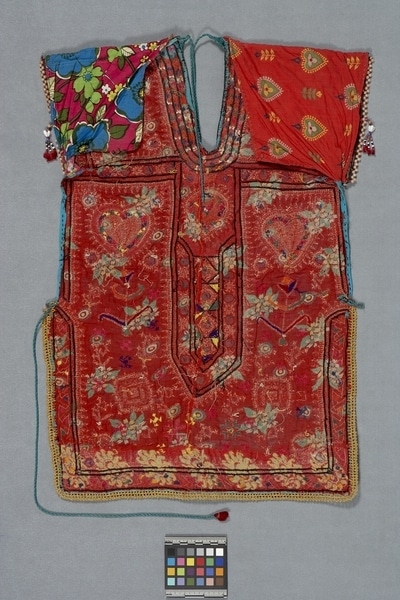Backless Blouse Item Number: 1098/4 from the MOA: University of British Columbia


Description
Woman’s or child’s turquoise cotton backless blouse, embellished with designs worked in gold and silver metal wrapped thread. The blouse is made from a large, heavily embroidered panel that forms the entire front of the blouse. There is a vertical neck opening at the centre front, bound with black embroidery; this opening is embellished with three rows of closely spaced circular metallic gold motifs. At each shoulder is a gold inverted heart-shaped figure. Below the armholes, the designs form an apron effect; the design elements, which are scattered over the entire surface, include hearts, squares, geometric forms, tree and flower motifs. Dark red pompoms, circular mirrors and silver and red sequins are placed within the motifs. The sleeve edges are trimmed with beads, sequins and beaded tassels. The bottom and sides are bordered with diamond-shaped motifs, sequins and gold metallic crocheted edging. On the back, separate, small shoulder yokes made from panels of multicoloured, machine-printed cotton broadcloth are sewn at the shoulders and at the underarms, forming close-fitting, abbreviated sleeves. The blouse fastens at the centre back neckline with green twisted fibre ties. There is also a green fibre tie located halfway down the left edge of the blouse and a fibre loop located at a corresponding place on the right-hand side. The embroidery is underlined with red printed cotton gauze.
History Of Use
Backless blouses are worn with a long, gathered skirt or baggy pants as part of the everyday or festive costume. The heavy use of gold metallic thread probably indicates that this blouse was worn on special occasions. A veil is worn over the head and shoulders, covering the back. An embroidered blouse front like this one is called a “greban” in Threadlines Pakistan, but the term “gaj” is used in Colours of the Indus (see References). “Gaj” is also spelled “guj” in the literature. The sales slip from Pakistan Handicrafts calls this garment a “Sindi Guj.”
Specific Techniques
couching stitch; satin stitch; buttonhole stitch
Narrative
This blouse was purchased by William McLennan at Pakistan Handicrafts in Karachi, Pakistan, in 1985 while he was on assignment for the Museum of Anthropology, which had a contract with the administration of Expo ‘86 to set up the Pakistan pavilion at the fair. The Museum purchased it, along with the other items in the 1098 accession, from McLennan in 1986. The style of this blouse is typical of others from Sindh, but the turquoise and gold colouration is unlike examples found in published sources.
Item History
- Made in Sindh, Pakistan before September 1985
- Collected by Bill McLennan during 1985
- Owned by Bill McLennan between September 1985 and January 30, 1986
- Received from Bill McLennan (Seller) and Museum of Anthropology Shop Volunteers (Funding source) on January 30, 1986
What
- Name
- Backless Blouse
- Identification Number
- 1098/4
- Type of Item
- blouse
- Material
- cotton fibre, glass, metal, shell and dye
- Manufacturing Technique
- embroidered, crocheted, beaded and sewn
- Overall
- height 61.8 cm, width 43.0 cm
Who
- Culture
- South Asian
- Field Collector
- Bill McLennan
- Previous Owner
- Bill McLennan
- Received from
- Bill McLennan (Seller) and Museum of Anthropology Shop Volunteers (Funding source)
Where
- Holding Institution
- MOA: University of British Columbia
- Made in
- Sindh, Pakistan
When
- Creation Date
- before September 1985
- Collection Date
- during 1985
- Ownership Date
- between September 1985 and January 30, 1986
- Acquisition Date
- on January 30, 1986
Other
- Item Classes
- textiles
- Condition
- good
- Accession Number
- 1098/0004